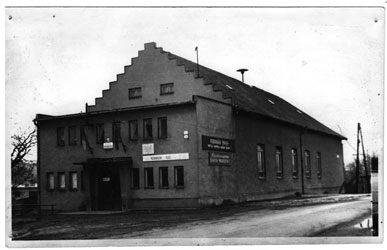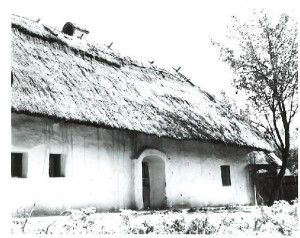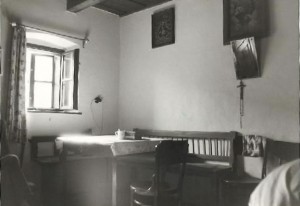Volkovce – a brief history of the village.
The earliest evidence of settlement in the area dates back to the Palaeolithic period, around 35,000 years ago, the period of mammoth hunters (chipped stone industry near the Majer area).The historic settlement also documents Neolithic stone hammers, ground wedge as well as the so-called linear pottery and weaving whorls.
Also documented were: a unique cast of copper hammers from the late Stone Age (about 3000 years before Christ - in the area of Zvandolina), a fraction of a bronze pendant and some bronze axes, thought to be dating back to the Bronze Age. A common occurrence of ceramics from the Lusatian culture – ashfields was also found. A rare ivory jewel box and pyxis from the Great Moravian period were excavated on the border of Volkovce and Čierne Kľačany. Several bones from prehistoric animals such as a diluvian deer antler and mammoth bones were also exhumed from the gravel mines.
The first written mention of Volkovce was found in a document from 1275. It was written by master Ladislav, an official from Ostrihom canonry during the reign of King Ladislav IV. The document confirms the exchange of land estates between master Štefan, the Tekov region Zhupan (note: Zhupan is a title of various positions amongst Southern Slavonic peoples, at the head of several types of units called ŽUPA) and the castle's lords Dom, the son of George and his brothers. All the attending parties declared that they “give and assign the estates called Mohala and Wolkouch”. These estates had previously fallen into the castle's territory and therefore it was more beneficial to be exchanged for other estates that belong to Master Dom and his brothers”.

The village hall - built in 1965 -1966
It is also estimated that the villages of Volkovce and Závada have existed since the 11th century. They are listed in a document dated 1075 as a portion of the village, part of Saint Benedict Abbacy. The noblemen serving the Abbacy became independent in 1358 and declared themselves “country gentlemen”. Written reference of Olichov dates back to 1209 and Závada to 1421, when the document mentions two villages: Veľké Volkovce and later Závada in 1424. Závada was the property of the Topolčianky estate (1527) and Volkovce of Saint Benedict Abbacy until 1506 when the Esztergom cannonry gained ownership.
An interesting reference to Volkovce, dated from 1327, is a record about an Abbot of Saint Benedict Abbacy, called Ladislav, who owned part of the estate in the region of Volkovce. The Abbot gifted the deeds to a manor house in the area of Volkovce to Pavol, also named the Literate, and his brothers. He gave Pavol and his brothers the area of Volkovce as a reward for their military services. Also listed in this document are the boundaries of Volkovce, including the defunct village of Zovny. The document also mentions that the villagers had a 10-year exemption from all taxes.
A document from the Zobor Convent dated from 1361 states "the King's man" John, son of Peter from Volkovce, who led the investigation on behalf of King Louis, was one of the king's officials. His wife, her ladyship Katarína, is also mentioned in the document from 1364 in conjunction with her dowry payment. Despite all the early documentation, after approximately 100 years, Volkovce became desolate (1437).
In 1535, the village completely burned down, which at the time was a common catastrophe as the houses were wooden with thatched roofs and no chimneys. According to a tax-based census commissioned in 1536, the village only had seven farmhouses. In 1549, there were twelve, and in 1600, forty-six houses within Volkovce, and four houses in Závada.

A house built in 1872
(owned by Tomáš Kurkin)
The Turkish occupation had a negative effect on community life in large parts of Hungary. The Turks reached the Tekov communities by the second half of the 16th century. Závada was devastated in 1599, and between 1631-1632 both municipalities suffered when the Turks dragged first five and then 10 children into captivity. In 1570 and 1663, the Turks made a detailed tax inventory of the local population, including the names of residents. The document shows 27 families in Volkovce, and three families in Závada. They also documented taxes on grain, wine, bee products, pigs, pastures, wooded areas, and two mills. The victory battle against the Turks by the imperial army was led by General Forgáč and took place in the nearby village of Vozokany in 1652. There are many stories and folk tales from the era of the Turkish invasion, and the underground bunkers remained for a long period in the nearby forest. Another census dated 1696 was held by the domestic Christian authorities.
Despite these hardships, in 1647, a school was founded in the village under the leadership of Juraj Benius, the teacher. The hardship persisted even after the defeat of the Turks. The residents requested that the taxes be lowered as much of the farmland was not occupied. The document lists 62 farmers in Volkovce and 31 in Závada. Documents from 1718 and 1720 that have been preserved up to the present time list the names of mayors and village residents. These indicate a more peaceful time of economic and social development. Also preserved was a detailed list dated 1769, listing the amounts of nonary payable from the peoples' harvest and also the responsibilities of the inhabitants in the village. During this period, wine production also expanded.
In the middle ages, the village belonged to the parish of Nemčiňany and according to canonical visitation in 1559, the village also housed the parsonage. This is no longer the case today. The church of St. Jacob was originally a Gothic church built in the 14th century. Both the exterior and interior (the pulpit) were rebuilt in 1754 in the Baroque style. The Volkovce residents were recorded as Roman Catholics; but a document from 1845 also lists people of Jewish faith, and towards the end of 19th century there is also a mention of Roma population.
In 1912, a train line connected Zlaté Moravce and Kozárovce, with a railway station built in the village.

Original interior decoration
During the First World War, the total death toll from Volkovce was 28, and 9 from the village of Závada. The names of the fallen victims are listed on the stone pillars of the church gates.
The Second World War ended with the village being liberated on 27th March 1945.
A cooperative farm was established in 1958 in the village and electricity was also introduced in the same year. The grammar school was rebuilt in 1960 and the village hall & mayor's office were built in the same year. The post office was established in 1976.
The villages of Volkovce and Závada were first merged in 1924-1931, and finally in 1945, they have formed the village of Volkovce as we know it now. The Olichov and Slance settlement areas are now also part of the village.
Summary prepared by: Doc. PhDr. Ladislav Mlynka, CSc., 15.12.2007
